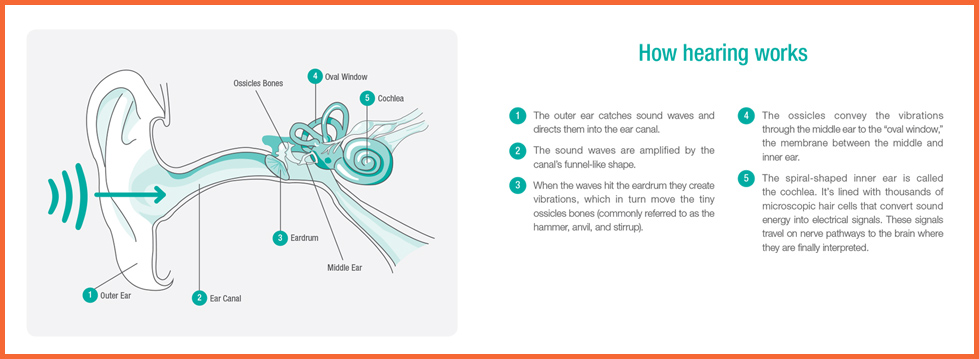
"I can hear but I can't understand."
This is a common complaint from people experiencing hearing loss.
"Everyone sounds like they are mumbling." - - "I can hear them but I can't understand what they're saying."
Have you had this experience or has a loved one or a friend mentioned that they can hear but not understand what others are saying to them? Most often, hearing loss affects the high frequency sounds a person hears. As a result, patients can have difficulty clearly understanding what other people are saying. Often patients can hear vowels just fine, but consonant sounds of F, S, T, and X are difficult to hear. Additionally, sounds like a woman's or child's voice, or a bird chirping are often lost. Losing hearing in those frequencies means that those sounds are softer and unclear.
Imagine removing all the high keys on a piano and asking someone to play a well-known melody. Even with only six or seven keys missing, the melody might be difficult to recognize. People with hearing loss experience a similar variation of the soundtrack of their lives every day.
Identifying hearing loss can be tricky
Because most cases of hearing loss develop gradually, it’s common for people affected to not recognize it. The sounds of chirping birds or rustling leaves disappear without them noticing. Only after it starts to affect speech recognition and communication do they become aware of the problem. With this delay, it’s important to treat hearing loss as soon as it is recognized.
When hearing loss is left uncorrected, it will begin to impact life in more substantial ways. Studies show that people with hearing loss are more likely to experience sadness, fear, depression and anxiety – all of which can cause them to withdraw from normal personal interaction.
Early intervention is important
The sooner steps are taken to manage hearing loss, the easier it will be to determine a solution. Our ability to hear is centered in the brain, and the longer it is deprived of certain sounds, the harder it will be to retrain the brain to hear these sounds later. Hearing aids can prevent or reduce the impact of this deterioration.
Receiving treatment can improve one’s quality of life dramatically. People who use hearing aids report these benefits: greater self-confidence, closer relationships with loved ones, and improved outlook on life.
Hearing Loss has been linked to:
Increased irritability and/or anger
Fatigue
Increased tension and stress
Reduced alertness and increased risk to personal safety
Impaired memory
An inability to learn new tasks
Reduced job performance and earning power
How You Hear - Ear Anatomy
I can hear but I can't understand, why?
 |
Most hearing loss occurs when the tiny hair cells in the inner ear bend or break. Physicians believe that prolonged exposure to loud noises and heredity are the main factors that contribute to hearing loss over time. Other causes of the damage can be related to: viral infections in the inner ear, medical treatments like chemotherapy and radiation, hear injury or age.
Types of Hearing Loss
A hearing exam will help determine the nature of your hearing loss.
In most cases your hearing healthcare professional can determine the nature or your hearing loss and quite closely pinpoint what caused it. Hearing loss can be either conductive or sensorineural, or both.
Sensorineural hearing loss
Sensorineural hearing loss is by far the most common hearing loss. The condition refers to problems in the cochlea or auditory nerve. Most are due to deterioration of the tiny hair cells that line the cochlea and transmit sound to the auditory nerve and then the brain. This accounts for 90% of permanent hearing loss.
Sensorineural hearing loss can't be corrected medically, but can usually be improved through the use of hearing instruments.
Conductive hearing loss
This condition is caused by any obstruction that prevents sound waves from reaching the inner ear. some of the causes of conductive hearing loss include; accumulation of earwax, a collection of fluid in the middle ear, abnormal bone growth in the middle ear, perforation of the eardrum. Most conductive losses can be treated medically, but there are times when hearing instruments are needed.
Audiogram
Speech Banana - the banana shape in the diagram below reflects speech sounds - sounds outside the banana are outside the speech range and include artificial sounds such as music or machinery or natural sounds such as birds chirping.

Hearing Exam
The softest sounds you hear at each pitch make up your hearing threshold and those thresholds are marked on your audiogram. Typically, the parts of the test given to you through headphones are called 'air' thresholds because the sound must travel through the air of the ear canal to be heard. An O is used for the right ear and an X is used for the left ear to represent your air thresholds.
A bone-conduction vibrator is usually used to test for thresholds as well. A < symbol is used for the right ear and a > symbol is used for the left ear. A bone-conduction vibrator is a device that gently rests on the bone behind the ear and is held in place by a small metal band stretching over the top of the head. This device transmits sound vibrations through the bones and tissue and fluids within the skull directly to the cochlea (the hearing organ of the inner ear). This process allows the examiner to bypass your outside and middle ear areas and test the sensitivity of your inner ear directly.
Hearing Exam Results
By combining the results of these two tests, your hearing healthcare professional can determine your type of hearing loss, how well you hear low, medium and high pitches, and which part of the ear is causing the loss.
If you believe you may be experiencing a hearing loss it is recommended to have your hearing tested as soon as possible. A hearing exam will let you know the status of your hearing health and your hearing healthcare professional will be able to recommend the next steps.
